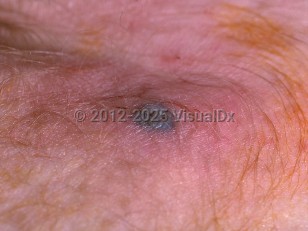Broadly defined, sepsis refers to the clinical situation in which there is evidence of bacteremia with associated systemic response: fever, tachycardia, increased respiration, and hypotension. At the far end of the sepsis spectrum, there is septic shock with inability to respond to fluid administration, advanced organ compromise, and changes in mental status. The common findings in sepsis include chills, rigors, fever, tachypnea, hypotension, skin lesions, and shock. Both gram-negative and gram-positive organisms can cause septic shock, as can systemic fungal and parasitic infection. Factors predisposing to poor outcome include diabetes, renal failure, alcohol use disorder, neutropenia, and advanced age. Individual infectious organisms have variations in the clinical presentation, and gram-positive organisms commonly can lead to toxic shock syndrome (TSS), described below.
Staphylococcal TSS – Staphylococcal TSS is caused by Staphylococcus aureus strains that can produce the toxic shock syndrome toxin-1 (TSST-1) and more commonly has the typical erythrodermic skin findings as compared to streptococcal TSS.
Streptococcal TSS – Streptococcal TSS is also caused by exotoxins that cause massive stimulation of T-cells via a superantigen mechanism. Clinically, the most common presenting symptom is severe pain in an extremity with or without underlying soft tissue infection. A prodrome of fever, diarrhea, and myalgias is often seen. The macular exanthem seen in staphylococcal TSS is much less commonly found in streptococcal TSS. Approximately 48-72 hours after the initial onset, shock and multiorgan failure follow. In this form of TSS, risk factors include varicella infection, bites, and lacerations.
Meningococcal disease – Meningococcal disease is a rapidly progressive infection caused by Neisseria meningitides, a gram-negative diplococcus bacterium. Symptoms may begin with a nonspecific viral-like illness that rapidly evolves (within hours) into one of two main presentations: meningitis or septicemia. Most cases are acquired through exposure to asymptomatic carriers via respiratory droplets. Children aged younger than 5 years and teenagers aged 15-19 are predominantly affected.
Sepsis with other bacteria may cause skin lesions in the immunocompromised host.
- Pseudomonas aeruginosa sepsis will occasionally present with skin lesions called ecthyma gangrenosum.
- Listeria monocytogenes infection is well documented in HIV-infected and renal transplant patients and neonates. In these patients, pneumonia and meningitis dominate the picture, but purpuric skin lesions may occur.
- Patients with complement deficiencies (late phase components C5-C9) or alcohol use disorder are susceptible to N meningitidis.
- Capnocytophaga canimorsus is a commensal in the saliva of dogs and cats.



